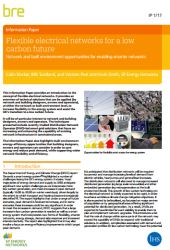Flexible electrical networks for a low carbon future: Network and built environment opportunities for enabling smarter networks
BRE (Building Research Establishment) is an independent, research-based consultancy, testing and training organisation, operating in the built environment and associated industries.
Flexible electrical networks for a low carbon future: Network and built environment opportunities for enabling smarter networks (IP 1/17) was written by Colin Sinclair, and published by BRE Scotland on 10 April 2017.
Equipment that delivers electricity to properties will need to be increasingly agile to meet energy demand requirements and assist in the transition to a low-carbon future. This will become crucial as low-carbon technology may increase peak network flows with surges in system voltage.
This information paper provides an introduction to the concept of flexible electrical networks. It offers an overview of technical solutions that can be applied by network and building designers, owners and operators, at either the network or built environment level, to increase flexibility in the energy system. It describes techniques tested in Scotland under the Flexible Networks for a Low Carbon Future project. It explains innovative technical solutions used to increase energy flexibility and to maintain network integrity and customer supply and service. This includes Distribution Network Operator (DNO)-led smart grid solutions that focus on increasing and enhancing the capability of existing network infrastructure in constrained areas.
The contents of the information paper are:
- Introduction.
- What is a flexible network?
- Enhanced network monitoring.
- Innovative techniques.
- Where to apply these techniques.
[edit] Find out more.
[edit] Related articles on Designing Buildings Wiki
- BRE articles on Designing Buildings Wiki.
- Building Research Establishment.
- Developing system intelligence for optimising building electricity networks.
- Electricity supply.
- Energy infrastructure.
- Energy storage.
- Microgeneration.
- Micro-grid.
- Renewable energy.
- Smart grid.
- Smart meter.
- The Future of Electricity in Domestic Buildings.
Featured articles and news
RTPI leader to become new CIOB Chief Executive Officer
Dr Victoria Hills MRTPI, FICE to take over after Caroline Gumble’s departure.
Social and affordable housing, a long term plan for delivery
The “Delivering a Decade of Renewal for Social and Affordable Housing” strategy sets out future path.
A change to adoptive architecture
Effects of global weather warming on architectural detailing, material choice and human interaction.
The proposed publicly owned and backed subsidiary of Homes England, to facilitate new homes.
How big is the problem and what can we do to mitigate the effects?
Overheating guidance and tools for building designers
A number of cool guides to help with the heat.
The UK's Modern Industrial Strategy: A 10 year plan
Previous consultation criticism, current key elements and general support with some persisting reservations.
Building Safety Regulator reforms
New roles, new staff and a new fast track service pave the way for a single construction regulator.
Architectural Technologist CPDs and Communications
CIAT CPD… and how you can do it!
Cooling centres and cool spaces
Managing extreme heat in cities by directing the public to places for heat stress relief and water sources.
Winter gardens: A brief history and warm variations
Extending the season with glass in different forms and terms.
Restoring Great Yarmouth's Winter Gardens
Transforming one of the least sustainable constructions imaginable.
Construction Skills Mission Board launch sector drive
Newly formed government and industry collaboration set strategy for recruiting an additional 100,000 construction workers a year.
New Architects Code comes into effect in September 2025
ARB Architects Code of Conduct and Practice available with ongoing consultation regarding guidance.
Welsh Skills Body (Medr) launches ambitious plan
The new skills body brings together funding and regulation of tertiary education and research for the devolved nation.
Paul Gandy FCIOB announced as next CIOB President
Former Tilbury Douglas CEO takes helm.
UK Infrastructure: A 10 Year Strategy. In brief with reactions
With the National Infrastructure and Service Transformation Authority (NISTA).
























